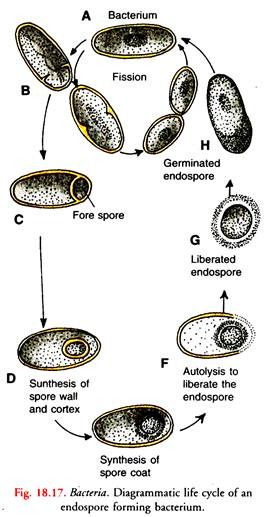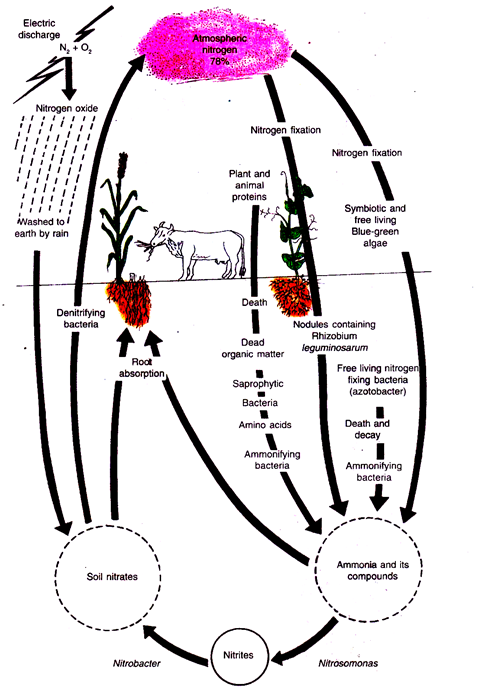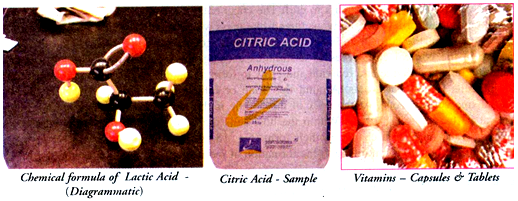In this article we will discuss about the beneficial and harmful activities of bacteria.
A. Beneficial Activities of Bacteria:
There are many kinds of bacteria without which we could not live. They are absolutely essential to the presence of life on earth. They make possible the continued existence of green plants and therefore of animals because the plants are the only source of food for animals.
Following is a brief account of the more important activities of the bacteria:
1. Role in Agriculture:
(i) Decay and decomposition:
Soil bacteria play an important role in brining about decomposition of organic matter. They serve a double purpose. In the first instance they act as scavengers removing harmful waste from the earth.
Secondly, they return it to the soil as plant food. The dead bodies and wastes of organisms (both plants and animals) are decomposed by the activities of the saprophytic bacteria.
In consequence a variety of elements of minerals of the earth such as carbon, oxygen, hydrogen, sulphur and phosphorus which make up their bodies are reduced to simple compounds such as carbon monoxide, water, nitrates, sulphates and phosphates.
Some of these go back to the soil and the rest to the air. From the soil they can be absorbed as plant food. This activity of the bacteria is used in sewage disposal system of cities. The bacterial action on the city’s sewage promotes decay.
As a result water is finally purified and changed into an odourless and valuable fertiliser instead of a dangerous and expensive waste product.
(ii) Soil fertility:
Some bacteria play an important role in maintaining and others in increasing soil fertility. The fertility of soil is proportional to its nitrogen content. Nitrogen is an essential ingredient of all living protoplasm. All growing plants, therefore, require it in their metabolism.
Atmosphere, no doubt, is four-fifths (80%) nitrogen, green plants generally are unable to use it. They mostly absorb it as nitrates and to some extent as ammonia from the soil.
Continuous absorption of these salts results in their exhaustion in the soil. Nearly all fertilisers for the soil include a large proportion of such soluble nitrogen compounds to promote plant growth.
In nature the presence of a regular supply of these salts is ensured by bacteria of certain types. These bacteria which function as Nature’s farmers belong to three categories, namely, ammonifying bacteria, nitrifying bacteria and nitrogen-fixing bacteria.
They are the agents of maintaining a continual circulation of nitrogen in nature between the plant world, in soil and the atmosphere. The series of changes through which the nitrogen passes due to the activities of these organisms constitute the nitrogen cycle (Fig. 18.18).
(a) Ammonifying Bacteria:
The saprophytic bacteria break down the proteins and other nitrogen containing remains of the plant and animal origin in the soil to amino acids by secreting enzymes.
The amino acids are then converted into ammonia by a group of bacteria called the ammonifying bacteria. The liberated ammonia may combine with carbon dioxide and water in the soil to form ammonium carbonate.
A few plants such as the common cereals can make use of ammonium compounds as a source of nitrogen. The majority of plants, however, cannot absorb ammonium compounds as a source of nitrogen.
(b) Nitrifying Bacteria:
Ammonia is very soluble. It moves in the soil rapidly and is acted upon by microorganisms of the category of chemosynthetic autotrophs in the soil. They are the nitrifying bacteria such as Nitrosomonas and Nitmbacter. They form nitrates from ammonium compounds.
The reaction takes place in the following two steps:
Nitrosomonas oxidizes ammonium carbonate to nitrous acid liberating energy. The nitrous acid then combines with bases in the soil forming potassium nitrite. Nitrobacter oxidizes nitrites to nitrates again liberating energy.
Neither the ammonifying nor the nitrifying bacteria add to the total quantity of combined nitrogen in the soil. The ammonifying bacteria convert amino acids into ammonia. The process is called ammonification.
The nitrifying bacteria convert nitrogen from the unavailable form of ammonium salts to the available nitrates. This process converting unavailable ammonium salts into available nitrates is called nitrification.
(c) Nitrogen-fixing Bacteria:
A considerable amount of nitrogen is lost by denitrification and through drainage. The loss must be made good by equal gains if the soil fertility is to be maintained.
The electric discharges in the atmosphere bring about the formation of traces of nitrogen compounds which are washed to the soil by rain water. The largest additions, however, come from a biological fixation process through the activity of two types of nitrogen-fixing bacteria.
Some of them live free in the soil and others in the root nodules of leguminous plants. They are able to make use of the atmospheric nitrogen and change it into nitrogenous compounds.
The nitrogen-fixing bacteria are thus unique in tapping a source of nitrogen not available to most other plants. This process of nitrogen transformation is called nitrogen fixation.
(i) Azotohacter heijerinckia (aerobic forms) and Clostridium (anaerobic) live free in the soil:
They take gaseous nitrogen from the air present between the soil particles. The nitrogen combines with other elements forming organic nitrogenous compounds. These compounds are assimilated by the bacteria.
In due course these bacteria die and their dead bodies containing nitrogenous compounds are decomposed by another type of bacteria called the bacteria of decomposition. During decomposition ammonia is produced.
The nitrifying bacteria convert this ammonia first into nitrites and finally into nitrates. Nitrates constitute the form of nitrogen needed by the green plants.
(ii) Rhizobium leguminosarum (syn. Bacillus radicicola) is another nitrogen-fixing bacterium:
It lives in the roots of such plants as Pea (Fig. 18.19A), Bean, Medicago and others. All these belong to the Pea family (Leguminoseae). Besides the legumes, the nodules are found on the roots of Alnus glutinosa, Casuarina, species of Coriaria and a few others.
The symbiont in non- leguminous plants is a member of Plasmodiophorales. The presence of bacteria in the roots causes the formation of little nodules (Fig. 18.19A). In Pavetta indica the bacterial nodules are formed on the leaves.
These nodules or the tubercles are the homes of millions of these bacteria. They have the ability to take up free nitrogen of the air and convert it into nitrogen compounds.
A part of the fixed nitrogen passes into the tissues of legume plant and a part diffuses into the surrounding soil. These bacteria enter into a mutually beneficial partnership with the host plant.
They give to the host the nitrogen compounds and receive in return carbohydrates manufactured by the host plant. This association is an excellent example of symbiosis. The legumes are very rich in nitrogen because of this association.
Some of our best protein plant foods come from the legume family of plants. The legume plants can flourish on land that has been depleted of its nitrogen by other plants. They are sometimes grown and ploughed under by the farmer when a foot or so in height.
The decaying bodies of these legume plants enrich the soil. They furnish a rich supply of nitrogen to the future crop. This is called green manuring. The soil on which repeated crops of cereals are grown becomes impoverished.
It can be enriched again by growing on it a crop of some plants of Pea family. This practice of alternating cereals with leguminous crop is known as rotation of crops. The leguminous plants contain more of nitrogen than they get from the soil salts.
The additional quantity is obtained from the air by Rhizobium. Neither Rhizobium nor the legume root alone can fix nitrogen.
Rhizobium lives in the soil where it has the form of coccus. The legume roots secrete substances which attract bacteria on to their surface. The bacteria, in turn, secrete a growth hormone which causes the root hairs to curl.
The cocci enter the curled root hairs. They grow in the root hair in the form of a continuous thread-like mass which finally reaches the root cortex. In this way many of the cortical cells become filled with a dense mass of these bacteroids.
Their presence in the cortical cell serves as a stimulus causing abnormal growth. The cortical cells around the infection divide and redivide and grow to form a nodule. A nodule comprises a central mass of cells full of bacteroids.
Around this zone of infection are a few cell layers thick of bacterial free cortical zone. At the apex of the nodule is the meristematic region and a vascular strand at its base (Fig. 18.19 B).
Within the host cells the cocci feed on the carbohydrates and other foods and undergo a change in their form (Fig. 18.19 C). They become V, T or Y shaped. The core of the nodule is red owing to the formation of red respiratory pigment haemoglobin.
2. Role of Bacteria in Industries:
Man has utilised the activities of bacteria for various industrial processes. The butter and cheese industries entirely depend upon the activities of the lactic acid bacteria.
The souring and curding of milk by lactic acid bacteria is another common example of application in everyday life. It takes place in two steps. In the first step the lactose sugar of milk is fermented into glucose by an enzyme lactose secreted by the lactic acid bacteria.
In the second step there is transformation of glucose into lactic acid. The latter sours the milk and coagulates the milk proteins (casein) forming curds and whey. Oxidation of alcohol into vinegar (acetic acid) is brought about by the acetic acid bacteria.
The curing of tea, tobacco and manufacture of indigo are other examples of useful chemical activities of bacteria which have been controlled for the benefit of mankind. The process of tanning hides in leather making and preparing sponges also involve the use of bacteria.
The production of linen is impossible without bacterial activity. The tough fibres, which are left behind, are separated. These fibres are spun and woven into linen cloth, ropes, etc.
The preparation of coffee and cocoa is also dependent upon bacterial action. The cocoa beans are white in colour and quite bitter in taste. The bacteria digest the bitter coverings of seeds and give the characteristic colour, flavour and aroma.
Many saprophytic bacteria in their metabolic activities excrete waste products of great commercial importance.
Some of these are:
(i) Lactic acid:
It is useful in tanning industries.
(ii) Citric acid:
It is used to give aroma and flavour to beverages, sweets and other foodstuffs.
(iii) Vitamins:
Vitamin B is the product of fermentation of sugars and starch by Clostridium acetobutilicum. The vitamins are used in medicinal preparations.
(iv) Butyl alcohol:
Butyl alcohol, acetone and ethyl alcohol are produced in one fermentation operation when a certain bacterium is allowed to act on cooked com starch. These products are important commercial solvents.
(v) Acetone:
It is an important ingredient of explosives and is also used in the manufacture of photographic films.
3. Role of Bacteria in Medicine:
1. Source of Antibiotics:
The milder antibiotics of bacterial origin are tyrothricin, subtilin, polymyxin B, and bacitracin. Bacillius subtilis is the source of subtilin. Bacitracin is obtained from a stain very much like B. subtilis.
The actionomycetes which are filamentous, bacteria-like organisms produce more powerful antibiotics such as streptomycin, aureomycin and terramycin.
2. Preparation of Serums and Vaccines:
These are substances which are used to develop immunity to various diseases in man. Serums are used in advance as a therapeutic measure. They are also used when a person actually suffers from a disease.
Diphtheria, lockjaw, pneumonia, etc. are the diseases in which the serums are effective. Vaccines are commonly used to make people immune to diseases like typhoid, small-pox, cholera, scarlet fever, etc.
In the preparation of serums, small doses of bacterial toxins (poisons) are injected into the blood of animals such as horses. To combat or neutralize the bacterial poisons, the body of the animal produces antibodies.
The blood of the animal is then withdrawn. Impurities such as blood corpuscles and other solid matter are removed from the blood. The clear blood liquid containing the antibodies is the serum. It is used as weapon to combat diseases caused by these bacteria.
To produce vaccines dead or weakened disease producing bacteria or their diluted poisons (antigens) are directly injected into a man to cause a disease in a mild form. As a reaction the host is stimulated to form antibodies.
The latter may remain for years in the body of the host imparting immunity against the same type of bacteria which may later enter his body.
This is an incomplete account of the beneficial activities of bacteria. Anyhow it indicated their extreme importance in everyday life. Because of these beneficial activities the bacteria are called the friends of mankind.
B. Harmful Activities of Bacteria:
1. Food Poisoning:
Of course, all activities of bacteria are not beneficial. Some saprophytic bacteria cause decay of our food and make it unpalatable. The activities of certain bacteria produce powerful toxins such as ptomains in the food.
These toxins are powerful enough to cause food poisoning which results in serious illness and even death. Some species of Staphylococcus are the common offenders.
There is another dangerous food poisoning bacterium known as Clostridium botulinium. It causes botulism—a fatal form of food-poisoning.
2. Disease:
Many parasitic bacteria are the causative agents of bacterial diseases. They cause diseases of our economic plants, domesticated animals and man. T.J. Burrill in 1878 first gave the information that bacteria cause plant diseases.
There are more than 170 species of bacteria which cause plant diseases. Usually they are rod-like and non-spore forming. Many of them have flagella.
The bacteria gain entry into the host through wounds or natural openings such as stomata, lenticels, hydathodes or through the thin epidermis.
The bacterial diseases of plants belong to the following categories:
(i) Wilt diseases caused by blocking of the vessels of host plant by masses of bacteria. The common example of this category are the wilt diseases of potato, cucumber, water melon and eggplant.
(ii) Crown gall and Hairy root diseases. These are due to overgrowth or hyperplasia. The crown gall of beets and hairy root of apple are the examples.
(iii) Narcotic blights, leaf spots and rots caused by killing of parenchyma cells. Fire blight of apple, and pear and soft rot of carrot and turnip are the common examples. The following Table 3 gives a list of some important disease-causing bacteria, host plants and diseases.
A list of principal bacterial diseases of man and animals have been given in the Table 4 given below. The most interesting thing is that these diseases are cured by the use of antibiotics. These antibiotics are prepared from the bacteria themselves which cause diseases.
3. Denitrification:
There are, sometimes, a group of bacteria in the soil which reverse the nitrifying process. They injure the soil by causing the loss of a part of its combined nitrogen.
This they do by breaking down nitrates into nitrites and nitrites into ammonia compounds or to free nitrogen.
NO3 → NO2 → NH3 → N gas ↑
The free nitrogen passes into the atmosphere and is lost to the soil. The result is the lowering of soil fertility. This process is called denitrification. The bacteria which bring about denitrification are called the denitrifying bacteria.
They are most active in the soil containing excess of nitrogen compounds such as the heavily manured soils. Soils deficient in oxygen are also favourable for the activity of this type of bacteria.
Denitrification is checked if the soil is well aerated by ploughing or digging and well drained. It is uneconomic to use natural and artificial nitrate manures simultaneously.
The denitrifying bacteria found in the faeces contained in the manures tend to destroy the nitrates.















